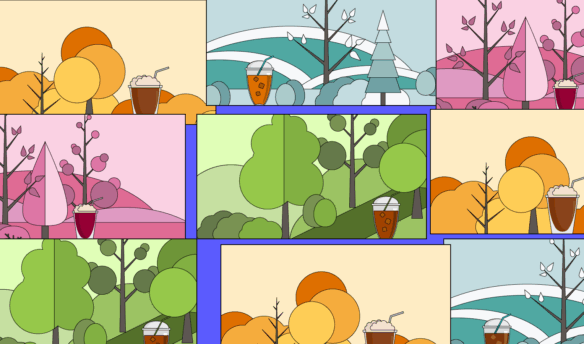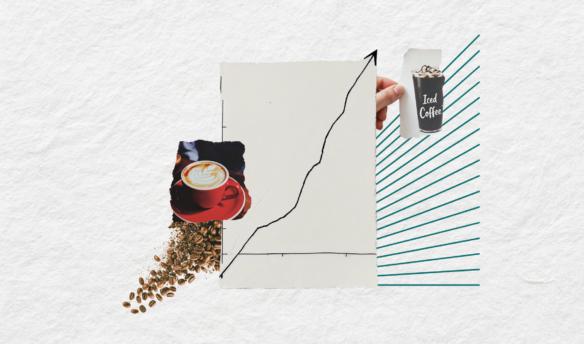On January 2, Starbucks announced that its new winter menu will feature a cortado—but in a size that has coffee connoisseurs scratching their heads.
The Starbucks cortado will reportedly contain three ristretto shots of Starbucks’ Blonde Roast espresso and steamed whole milk, served in an 8oz cup. Along with this standard cortado, Starbucks will also introduce a brown sugar version made with oat milk.
There’s just one problem: At eight ounces, the Starbucks cortado is double the size of what most coffee shops already serve and call a cortado. The drink is generally defined by a 1:1 ratio of espresso to milk, which should clock in at between 4 to 4.5 ounces of liquid. To further complicate matters, Starbucks Reserve shops—Starbucks stores that feature exclusive and single-origin coffees—already serve a 4.5oz hot honey cortado, in the same Gibraltar glass that Blue Bottle Coffee started using in 2005 for its eponymous drink.
With its new cortado, Starbucks seems to be doing the same thing that it did with the macchiato: creating an entirely new drink, but calling it by a name that already had an established meaning. So we asked coffee shop owners and professionals: What do they think of the Starbucks cortado—and how do they see it changing customer behavior?
Reinventing the Wheel
The cortado’s history dates back to the early 20th century, when it was created in the Basque region of Spain. It was named for the Spanish verb “cortar,” which means “to cut,” since the addition of a little steamed milk helps to cut the intensity of espresso.
The cortado eventually gained worldwide popularity, and became a coffee-shop staple. Today, the drink goes by many different names. In Australia, it’s known as a piccolo; in the U.S., it’s sometimes called a Gibraltar, thanks to Blue Bottle. In Cuba, similarly sized drinks are sometimes called cortaditos, and in France you can order a café noisette— “noisette” means hazelnut in French, the ideal color of the espresso after it’s lightened with a touch of milk or cream.
Whatever you call it, the cortado has long been defined by its equal parts espresso and milk. Starbucks’ decision to debut a drink that ignores this fundamental feature will almost certainly throw a wrench in how customers come to understand the drink.
“The introduction of an 8oz cortado by a giant like Starbucks certainly has ripple effects across the industry,” says Daniella Senior, CEO of Colada Shop, a Cuban coffee shop with locations across the Washington DC metro area. “When a dominant player like Starbucks adjusts the standard definitions, it risks creating confusion among customers who may no longer be certain about what to expect from their favorite beverages. For smaller establishments, maintaining the integrity of traditional coffee definitions is crucial to preserving the unique experiences that differentiate us from the chains.”
However, Senior also recognizes the opportunity to educate customers about the rich history and nuances of different coffee drinks, including Colada Shop’s cortadito, which it serves with espresso, steamed evaporated milk, and whipped espresso sugar. “By clearly communicating what a cortadito truly represents,” she says, “we can reinforce our commitment to quality and authenticity, ensuring that our patrons have a clear understanding of what makes our offerings special.”
Marco Suarez—the co-founder and CEO of Methodical Coffee, based in Greenville, South Carolina—agrees that it can be challenging when Starbucks co-opts traditional coffee names and creates entirely new drinks. But he is hopeful that savvy coffee drinkers will not be fooled. “Specialty coffee has come a long way in America,” he says. “Ten years ago, most people’s coffee experiences were primarily Starbucks. Today, however, consumers are far more knowledgeable and experienced with craft coffee, making this new launch from Starbucks less worrisome.”
For Justin Jones, co-founder and director of operations at the Indianapolis-based Bovaconti Coffee, Starbucks’ version of a cortado is “an overpriced, dull, extra-small latte.” He says he’s not at all surprised at the brand’s cortado misnomer, thanks to its history with the macchiato and the flat white (the company added the latter drink to its menu in 2015; it also differs from accepted industry standards). “I don’t think anyone will ever know fully why they intentionally mislead their customers,” he says.
That said, Jones isn’t too worried about customers getting confused. “Starbucks is showing up to this game really late and will likely be the fool in this scenario,” he says. “In my experience, the cortado is almost universally understood, and a quick web search will quickly dispel any false claims that a cortado is anything but equal parts espresso and steamed milk.”
Washington DC’s Cameo Coffee + Tea has a classic cortado on its menu, served in a Vero glass by the LA-based design brand notNeutral (the Vero glass was also featured in Fresh Cup’s 2024 gift guide). Cameo’s menu features other drinks that play with traditional definitions, like its “matchatado,” a mashup of a matcha and a cortado using ceremonial-grade matcha by Spirit Tea.
“We’re confident we could walk a new guest through our approach and how it may differ from Starbucks,” says director Kenia Euceda Canales. Despite the fact that Starbucks has created confusion around other established coffee drinks in the past, Canales is sure that shops will be able to weather the storm. “Specialty coffee shops are not new to these types of conversations, and maybe it’s time we take credit for bridging the gap.”
















